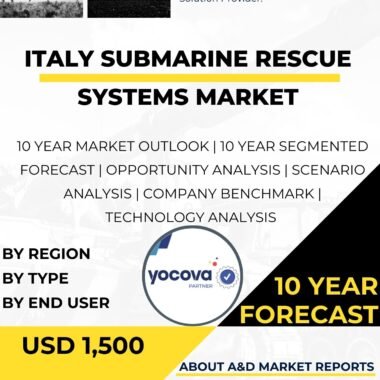Description
The Japan submarine rescue systems market plays a crucial role in ensuring the safety and effectiveness of the nation’s submarine fleet. Submarines are essential assets for Japan’s maritime defense, providing a strategic advantage in safeguarding its territorial waters and interests in the region. However, submarine operations entail inherent risks, and in the event of an accident or emergency, specialized rescue systems are vital for the timely and effective recovery of submariners. The submarine rescue systems market encompasses a range of equipment, technologies, and capabilities designed to facilitate the rescue of submariners in distress and enhance the overall safety and readiness of Japan’s submarine force.
One of the primary applications of submarine rescue systems in Japan is in ensuring the readiness and operational availability of its submarine fleet. The ability to rapidly respond to a submarine in distress is critical to minimize the risks posed by accidents or equipment malfunctions during underwater operations. Submarine rescue systems are designed to provide swift and efficient assistance to submarines in need, enabling prompt response and effective rescue operations.
Moreover, the submarine rescue systems market in Japan is instrumental in enhancing the safety and morale of submariners. The knowledge that robust and reliable rescue systems are in place provides submariners with confidence and reassurance, enabling them to focus on their duties and missions with peace of mind.
Furthermore, submarine rescue systems play a crucial role in supporting international cooperation and interoperability. Japan’s maritime forces frequently engage in multinational exercises and operations with allied navies. A standardized and compatible submarine rescue system enables seamless integration with the rescue capabilities of partner nations, enhancing joint rescue operations and mutual assistance in times of crisis.
As Japan emphasizes indigenous defense capabilities, the domestic production and development of submarine rescue systems have seen substantial growth. Collaboration between the government and domestic defense industries has led to the creation of state-of-the-art rescue equipment tailored to Japan’s specific operational requirements.
Japan’s alliance with the United States has also played a significant role in advancing its submarine rescue capabilities. Collaborations with the U.S. Navy, which possesses one of the most extensive submarine rescue capabilities globally, have facilitated technology transfer, joint training, and exercises, contributing to the modernization of Japan’s submarine rescue systems and enhancing interoperability with allied forces.
The submarine rescue systems market in Japan also benefits from advancements in technology and innovation. Improvements in subsea robotics, remotely operated vehicles (ROVs), and rescue chamber technologies have enhanced the effectiveness and efficiency of rescue operations. These developments enable rescuers to conduct deep-sea operations with greater precision and safety.
However, the submarine rescue systems market in Japan also faces challenges related to cost, maintenance, and human resources. Developing and maintaining a comprehensive and reliable submarine rescue capability requires significant investments in equipment, infrastructure, and training.
Additionally, ensuring the availability of skilled and qualified personnel to operate and maintain the rescue systems is essential for their optimal performance during rescue operations.
Furthermore, the submarine rescue systems market must adapt to the evolving threat landscape, including potential risks posed by advanced submarine technologies and underwater operations. Continuous research and development are necessary to address emerging challenges and threats.
In conclusion, the Japan submarine rescue systems market plays a vital role in enhancing the safety and readiness of the nation’s submarine fleet. Collaboration between the government and domestic defense industries, as well as international partnerships with allied nations, fosters innovation and contributes to the growth of the domestic submarine rescue systems market in Japan.
Addressing challenges related to cost, maintenance, human resources, and emerging threats is crucial for further enhancing Japan’s submarine rescue capabilities and ensuring that its maritime forces have access to advanced and reliable systems to support submarine operations, enhance force protection, and contribute to the nation’s operational excellence and safety.
With its strategic focus on indigenous defense capabilities, partnerships with allied nations, and commitment to the safety and effectiveness of its submarine force, Japan remains dedicated to leveraging advanced submarine rescue systems to safeguard submariners, enhance military capabilities, and contribute to regional and global maritime security.




